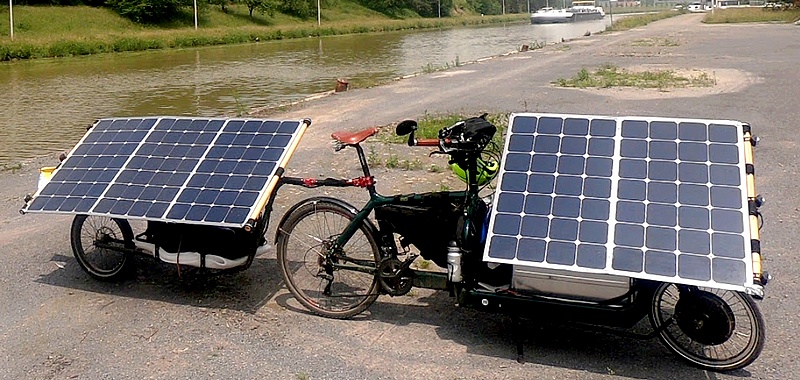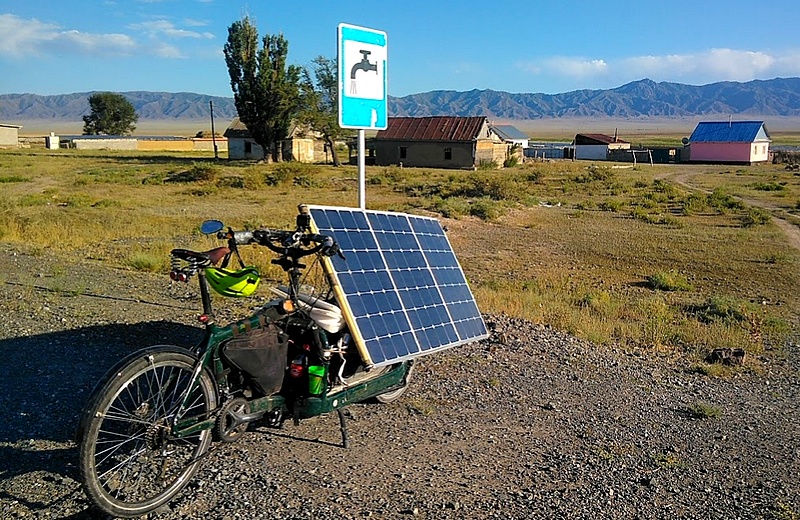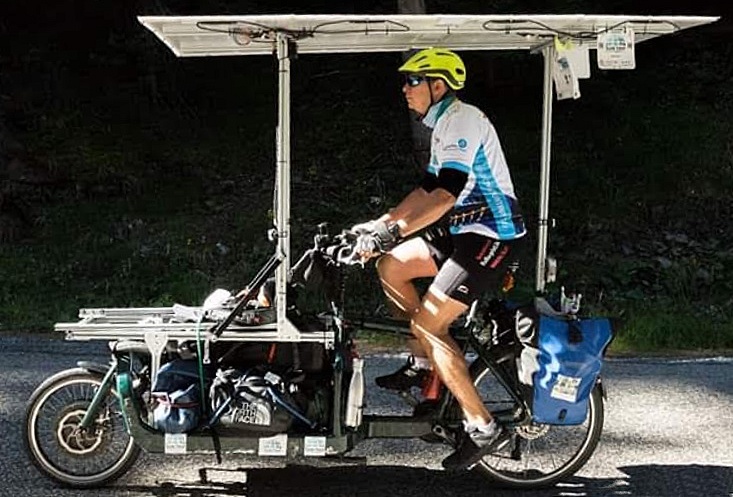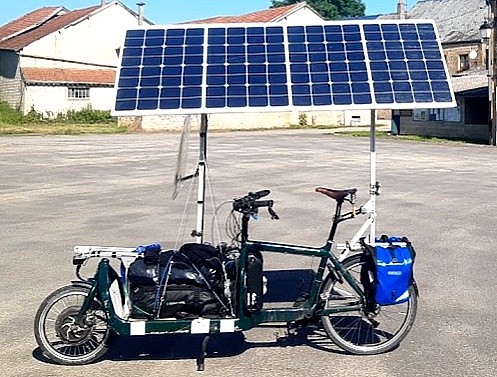Introduction

I designed this solar cargo bike to participate in the Sun Trip 2018, a 12,000 km course from Lyon (France) to Guangzhou (China). I chose a 2-wheeled cargo bike, to which I added a solar trailer.
Technical description
Cycling
I chose the Larry vs Harry cargo bike from the Bullitt brand:
- 20-inch wheel at the front, 26-inch wheel at the rear;
- TRP Spyre mechanical disc brakes for easy repair worldwide;
- Old-fashioned 3×8-speed derailleur for repair possibilities worldwide;
- Direction Jones H-bar and easy to mount rod for multiple hand positions;
- Brooks saddle in wide leather, for many hours on the bike!
- 1 large aluminum trunk at the front that can be locked for all luggage;
- Schwalbe Marathon Plus tires for the highest possible puncture protection.
The trailer
I opted for a trailer with 20-inch SunTravel wheel (now SolarMoov).
Motorization
The Direct Drive Crystalyte HT3525 motor is installed on the 20-inch front wheel. It is powered by a Phaserunner controller from Grin Technologies. It is a high-torque motor, but with a top speed of 45 km/h due to the field weakening feature of the Phaserunner controller. Thanks to this Direct Drive motor, I benefit from powerful regenerative braking thanks to the controller.
Characteristics:
- Max speed: 45km/h
- Max power: 1250Watt (battery powered)
- maximum torque 110Nm
- Max phase current: 90 A
- Max regeneration current: 15 A (about 750 Watt)
This combination was a very powerful configuration with high acceleration possibilities and high regeneration possibilities. The top speed of 45km/h was reached because of the weakening of the field, which was not economical at the highest speeds, but these speeds were only used when necessary, for example in tunnels or to escape angry dogs…😊
The battery
In 2018, I had a 48V 20Ah Lifepo4 battery. The advantages of the Lifepo4 are safety and longevity but the battery was heavy (8 kg). I had protected it from shocks and rain in an Ortlieb waterproof bag. It survived the Sun Trip 2018 very well at temperatures up to 45°C and its capacity was still 95% six months after the end of the Sun Trip (12,000km). Today in 2022, the battery still has 80% of its original capacity.
Solar equipment
At the beginning of the trip, I had 3 panels of 90 Watt-peak (4×7 cells) on the trailer and 2 panels of 90 Wp at the front of the bike, a total of 450Wp I had bought Chinese panels on an online sales platform. The quality was reasonable, but not perfect. I chose panels made on an aluminum base plate. During a strong storm in Baikonur, Kazakhstan, 2 solar panels deformed. Later, the trailer broke. After these 2 events, I installed the 3×90 Wc panels of the trailer at the front of the bike and gave the trailer to 2 Kazach truck drivers, as well as the 2 folded solar panels. From that moment on, I only had 270Wc instead of the 450Wc of the beginning.

Feedback
Positives
- Although long and big, my bike was easy to handle;
- I've always had the feeling of riding a "normal" bike;
- Its design was simple;
- Its design was redundant: I designed the bike to work with or without a trailer. In fact, when my trailer broke, I was easily able to move the solar panels to the front. I had also foreseen the possibility of a major breakage on the cargo bike: in this case, I would have installed the 20" motorized front wheel on the trailer to obtain a drive trailer. In this configuration, any ordinary bike could be used;
- The 20-inch wheel direct drive motor, paired with the Phaserunner controller, is a perfect combination for a powerful setup;
- Parking: The bike installs in seconds thanks to the sturdy cargo bike stand.
Negatives
My experience of the Sun Trip 2018 showed me that the solar structure could be improved, especially in terms of protection in case of a fall of the bike.
The evolutions of my bike
In 2019, I designed a solar roof on an experimental basis. Danu Jenni had convinced me that a solar roof was possible on a 2-wheeled bike and the combination of the cargo bike with the solar roof was very tempting. This design was successfully used in 2019, 2020 and 2021.
2019: Design with aluminium system profiles

2021: Design with steel cables

Evolutions / my next bike
- Improvements to reduce risks when the bike falls: foldable roof in 3 parts, which can be folded up to the front cargo space;
- Addition of a 2nd engine in the rear wheel so as not to heat up at all in the mountains;
- Design of a 2-wheel tandem with a solar roof
